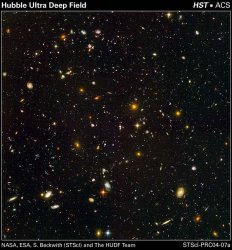Milky Way - Explanations
Okay, a couple of explanations.
First off, this is a Real shot and a single exposed image.
Next, it was really a 30 second exposure. To my eye looking at the full sized (8MP) original, it does have a little bit of fuzziness due to star movement, but the angular change was very small given that it was a 19mm lens. The sharpening probably helped some too, as did likely also the Photoshop downsampling from an 8MP original.
For a contrasting example, here's another 30sec exposure taken the next night with my other lens for that trip, my 70-200 f/2.8 IS. The EXIF data here says 73mm @ f2.8 @ ISO 1600 @ 30sec and you can easily see the star movement trails:
The full frame (but downsized) image:
A crop out of the above frame to 100% pixels:
FWIW, both of the above are "zero'ed out" RAW conversions - no adjustments.
If I apply the same RAW conversions and unsharp mask, the 100% crop would become the following (sorry, I grabbed a different part of the frame):
Needless to say, I don't consider this shot, regardless of how it could be processed, to be a "keeper". It is revealing in just how much the tungsten color setting affects the perceived colors.
Back to yesterday's shot, its brightness despite the apparent lack of star trails was IMO definitely helped with its post processing. The main thing I referring to here is the +1.5 on the exposure, which if I recall my camera physics correctly means that the effective light gathering would have been improved by +1.5 stops.
This means that the light gathering is equivalent to a (30sec)(1+1.5) = 90sec exposure. Given also that the camera was cranked to ISO 1600, the equivalent shutter times for slower ISO's would have been:
30sec --> 60sec @ ISO 800 --> 120sec @ ISO 400 ... 480sec @ ISO 100 (8 minutes)
or considering the +1.5 exposure post-processing contribution:
90sec --> 180sec @ ISO 800 --> 360sec @ ISO 400 ... 1440sec @ ISO 100 (24 minutes)
Finally, a very good comment, because it gets us into a different topic:
There's no way one could see THAT many stars, especially with a light source like a candle in the frame.
We talk a lot about image manipulation these days, mostly because it has become easier to do with digital. What we tend to conveniently ignore is that the human eye is an amazing device, and the camera is sometimes a very poor substitute.
As I want to apply that comment here, we talk frequently about a camera/film systems "Dynamic Range", which is its ability to capture the dynamic range within an image. With digital, we're doing overlays and other exposure tricks to try to make our hardware effectively have a broader range, in an attempt to more faithfully reproduce what we saw when we were there: this is all an attempt to make the camera more closely reproduce what we saw with our eye, but unlike our eye, the camera's f/stop can't instantly change as it pans within a scene.
The human eye can adapt to six full orders of magnitude (roughly 0.1 lux to 100,000 lux), although I don't know how quickly it adapts "instantly" while we purview a scene. As such, while I'm sure that the light pollution from the candle inside our banda did wash out some of my view of the stars from right at that location, our view of the stars and the milky way on our walk back and before we lit the candle (to go find the camera gear) did roughly appear to be this dramatic.
From a purist point of view, I may have pumped up this shot by a half, or maybe a full stop, but in balance, since I allowed the banda light to become overexposed, this is nothing that a longer shutter exposure - - and/or good old fashioned "push processing" on film - - would not have also accomplished.
All in all, I'm downright amazed at how far the dSLR technology has come in making a shot like this so relatively easy to take.
And next up for me is to digitize a 35mm slide where I purposefully used "chimping" on the dSLR to figure out the sunset exposure settings I wanted for the desired image on the 35mm Velvia. Hopefully I'll have that task done by this weekend.
-hh
![mufindi_starry(20D_20060621_1437).jpg]()









